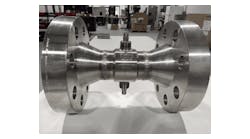While flowmeters are calibrated under ideal laboratory conditions, the environments into which they are installed vary greatly. It is therefore incredible to see today in the billion-dollar oil and gas industry that most flow measurement systems are reporting flow rates with no consideration of measurement uncertainty. Uncertainty analysis is essential to determine whether measurement systems can meet required performance targets.
It is a popular misconception that measurement is an exact science. In fact, all measurements are merely estimates of the true value being measured, and the true value can never be known. The terms “accuracy” and “uncertainty” are also misused in the oil and gas industry.
Accuracy refers to the agreement between a measurement and an expected true value. Therefore, accuracy requires two measurements with two different meters. Accuracy cannot be discussed meaningfully unless the true value or most probable value is known or can be recognizable.
On the other hand, uncertainty is an interval defined around the average, which is based on the data collected over a given period that is considered a stable flow condition. The true value can be expected to be within the confidence level inside the interval defined during the measurement. The size of the interval is described as a confidence interval or in terms of sigma (i.e., standard deviation from a statistical point of view). To make multiphase flowmeters easily comparable and effectively report their performance, the multiphase flow metering community has decided to follow the 95% confidence level or 1.960 multiplied by 1 sigma.
From a practical point of view, this means when a measurement is made repetitively (under continuous stable flow), then a standard deviation can be calculated using the numerous collected data. This is defined as 1 sigma (σ), which means there is a 68.27% chance that the true value is within this interval. This standard deviation σ is multiplied by 1.960 and provides the performance or uncertainty interval with a 95.00% confidence interval. This is shown in Figure 1.
Allowing for uncertainty
So, how can oil and gas operators effectively allow for this uncertainty? The ideal approach would be to calibrate every individual flowmeter device for the specific conditions it will encounter. However, this is not financially realistic, and to establish a flowmeter’s performance, an uncertainty budget must be constructed that considers additional uncertainties arising from interpolation and extrapolation from calibration conditions.
First, calibration against a single-phase meter at least three to four times better than the device in question is needed. This is done in a third-party flowloop facility — the best being a primary calibration facility. Second, the repeatability performance of the flowmeter must be established (effectively, this is the closeness of agreement between successive measurements made under the same conditions) in its estimation of the overall uncertainty of the calibration. The repeatability is demonstrated by maintaining the flow conditions of operation and simply switching the device off and on. Any possible deviation that appears will need to be taken into account as repeatability.
Reproducibility is another essential parameter from the end user’s point of view. This is established by moving from a given condition, such as pressure or choke opening, etc., to different conditions and then returning to the previously given conditions. Meter drift is a systematic uncertainty that should also be accounted for, as this determines how the error in the measurement process will change over time. Bias is well-documented and addressed in ISO 21748, and it could also be a source of uncertainty.
Stability is another parameter to consider; if there have been multiple calibrations of the same flowmeters over the years, this will be the standard deviation of the calibration results. The standard uncertainty and the associated stability on the reference measurement should also be taken into account.
Accurate comparison
To establish the performance of an installed flowmeter against a reference flowmeter, some prerequisites are necessary. For example:
- Both devices must be physically as close as possible, so changes between them in line pressure and temperature are minimal.
- Both devices must record data at the same time.
- Both devices must use the same pressure-volume-temperature (PVT) package to perform the conversion from line to standard conditions, or from the in-use flowmeter conditions to reference flowmeter conditions.
- If the devices are far from each other, the cumulative volume measured must be three times larger than the storage volume between both flowmeters. It is important to remember that the longer the recording, the better the established comparison of both devices will be.
- If the devices are far away and the flow reaches the in-use flowmeter long before the other device, then the reference flowmeter recording time should be defined and shifted in order to capture the same type of flow passing through both meters.
- No choking should occur between both devices to keep the PVT package consistent and for the quick evaluation of the line or standard conditions of both devices.
- Both devices should be within the sweet spot of their working envelope.
- Both devices should be set with the relevant intrinsic fluid properties package, or equations of state (EOS) to ensure proper calculations.
- The reference flowmeter’s transmitters or sensors should be within the specification and zero trimmed or corrected for deviation in order to account for any potential bias.
To ensure validity of flowmeter measurements, comparison tests can be conducted either during the buying process, before delivery, or sometimes later when results do not match client expectation or reservoir model forecasts. Validation of test comparisons in well-controlled conditions and with very good uncertainty of the reference measurements can be achieved by a third-party that is familiar with field well test operations. This helps to avoid any conflict about who is right or wrong and provides a clear final statement based on statistical analysis, physics and field expertise. This work should therefore not be left in the hands of the meter manufacturers, as they can be overoptimistic about the performance of their product.
Dr. Bruno Pinguet is a multiphase domain senior advisor at TÜV SÜD National Engineering Laboratory, a world-class provider of technical consultancy, research, testing and program management services. Part of the TÜV SÜD Group, it is also a global center of excellence for flow measurement and fluid flow systems and is the UK’s Designated Institute for Flow Measurement.

Bruno Pinguet | Multiphase Domain Senior Advisor at TÜV SÜD National Engineering Laboratory
Dr. Bruno Pinguet is a multiphase domain senior advisor at TÜV SÜD National Engineering Laboratory, a world-class provider of technical consultancy, research, testing and program management services. Part of the TÜV SÜD Group, it is also a global center of excellence for flow measurement and fluid flow systems and is the UK’s Designated Institute for Flow Measurement.



